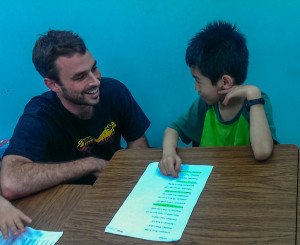Different Learning Styles

Every student in your class will have different learning styles. They are all in some way unique – their personality, their interests, their background, their language ability, and the way that they learn.

Knowing about all the different ways that your students learn can help identify which learning styles your students have, and figure out how to reach those students who might not respond to auditory and visual teaching.
Auditory
These students learn best from listening. They’ll pick up vocabulary and grammar the quickest from hearing you talk, from music and song lyrics, from movies and TV shows, or from overhearing conversations.
These students need: lots of conversation, music, dialogue, listening practice, reading out loud.
Visual
Pictures, diagrams, images, sentences on the board, lists, and any other visual aids you can think of are going to have the biggest impact on these students. These students
These students need: lots of pictures, new vocabulary and grammar patterns written on the board, written works such as worksheets or word searches.
Tactile
Tactile learners need things that they can touch, manipulate, and feel.
These students need: Concrete examples of vocabulary words (i.e., if you are teaching the word “stapler,” give them a stapler to hold), arts and crafts, their own sets of flashcards, card games or board games.
Kinesthetic
These students can be similar to tactile learners in that they need plenty of physical stimuli to keep them engaged, but with kinesthetic learners, movement is key. They often learn, think, and process ideas better while walking or doing some other sort of full-body movement.
These students need: physical games, movement, dance, to be able to spend time out of their chairs.
Analytic
These students tend to think very logically and linearly, and often have a hard time with irregular spellings and grammar rules because they can’t find the logic behind it.
These students need: Clear explanations, well-defined grammar patterns, step-by-step instructions.
Global
Global learners are the exact opposite of analytic learners. They tend to pick up on the bigger picture before the details. They are good at grasping concepts and intuitively picking up on manners of speech and grammar patterns, but will often struggle with organization and language rules. These will be the students who can intuitively communicate ideas and incorporate phrases and grammar that they hear from you, but will often overlook or completely forget basic grammar and spelling rules. These students
These will be the students who can intuitively communicate ideas and incorporate phrases and grammar that they hear from you, but will often overlook or completely forget basic grammar and spelling rules. These students
These students need: opportunities to slow down and go back to perfecting the basics, short stories, anecdotes.
Social/Interpersonal
It’s not that these students need other people around them to tell them the answers or help them figure things out; it’s that being part of a group, explaining things to others in the group, and working through ideas socially is integral to their learning process. In other words, the social dynamics and interactions are key to how they process and internalize information. These students need: lots of group work and paired work.
In other words, the social dynamics and interactions are key to how they process and internalize information.
These students need: lots of group work and paired work.
Solitary
Students with this style learn better on their own. That may be through reading, listening, or writing, but having the time and space to work mostly by themselves and to process and work through things in their head, is essential to these students’ understanding of what they are learning.
These students need: quiet solitary work time.
Keep in mind that most students aren’t just one learning type. You may have a student who is very clearly a kinesthetic learner, as well as global and social. Think of these more as guidelines to notice certain trends in your students’ learning styles instead of hard and fast categories that they will fit into.
Also, keep in mind that anyone will still learn from methods that don’t perfectly fit their learning style, they just won’t learn as quickly or as confidently. But being aware of the many different ways that students learn is helpful in identifying why some of your students may be struggling and what you can do to help them.



